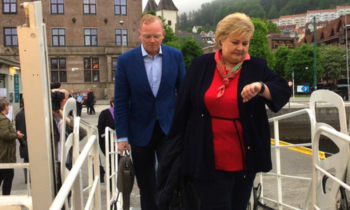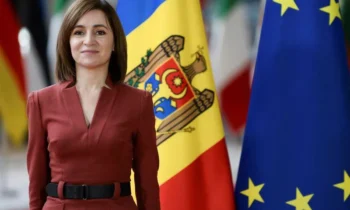
Norway’s conservative prime minister, Erna Solberg, will be able to govern for four more years following Monday’s (11 September) elections if she continues to work with the right-wing, anti-migrant Progress Party.
There are many examples of junior parties in governing coalitions being punished by voters, but not so in Norway.
“Because we have been honest there is still support for us after four years as the junior party in government,” said a happy Progress Party leader Siw Jensen, when it became clear her party had lost only 1.1 percent support, still getting 15.3 percent of votes and coming out of the elections as Norway’s third largest party.
Solberg herself also lost just 1.7% support compared to the last elections four years ago. Her conservative party remained the second largest party, backed by 25.1 percent.
Difficult talks on forming a new government will start already on Tuesday.
Solberg and Jensen’s coalition depends on support from two smaller parties – the Christian Democratic Party and the Liberal party – who both barely passed the 4 percent threshold to get into parliament, respectively winning 4.2 percent and 4.3 percent of the votes.
The most exciting moments during election night were watching how these two small parties moved above and below the threshold several times during the vote count.
Had they not made it into parliament, Solberg would have lost her majority.
Christian Democratic Party leader Knut Arild Hareide said his party will not join a new Solberg-led coalition, but also that he would not help to topple it by voting against its policies in parliament.
This means Solberg will be able to form the next government together with the Progress Party, but that she may have a difficult task to rule her country in the coming four years.
“We want a centre-right government, so we’ll see what’s coming. If it does not become that kind of government, we are in opposition”, said Hareide during a party leaders’ debate on Monday evening
Norway has fixed election periods of four years, meaning that the next election will not happen before September 2021.
The biggest party lost
The Social Democrats came out as the biggest loser in these elections despite remaining Norway’s largest party, supported by 27.4 percent of voters.
Exactly as it happened four years ago, when the Social Democrats were also the biggest party, it cannot form a government because it does not have enough supporting parties.
Both the Socialist Left Party and the rural Centre Party gained support on Monday, but, together with the Social Democrats, they are still not able to get the support of more than 79 MPs, which is short of the 85-majority needed in Norway’s parliament, the Stortinget.
The Center Party came out of Monday’s elections as the biggest winner and is now the fourth largest party in Norway with 10.3 percent of the votes.
This was an improvement of 4.8 percentage points from the parliamentary elections in 2013.
Center Party leader Trygve Slagsvold Vedum pointed out that not since the battle over whether to join the EU in the first half of the 1990s had there been such a good result for the party.
It campaigned for rural areas, decentralisation of power, and to end the current economic cooperation deal (EEA) with the European Union.
The Socialist Left Party also wants to end the EEA deal. It scored 6 percent of the votes, up 1.9 percent.
Overall only four parties gained in the elections – and all four of them had been campaigning to end the EU deal that gives Norway access to the internal market in return for accepting all related EU legislation.
While Solberg’s two cliff-hanger parties made it into the parliament on the margins, it went the opposite way for the Social Democratic leader, Jonas Gahr Stoere’s two allies.
The far-left Red party received 2.4 percent and the Green Party 3.2 percent, which was not enough for either of them to pass the threshold.
Their votes were not totally wasted. Based on a very strong result in capital Oslo, Red party leader, Bjoernar Moxnes, gained one seat for himself in parliament. It is the first time the Red party will have an MP.
The initial results show that a record 70 women were elected – three more than in the last elections in 2013.
(euobserver)



